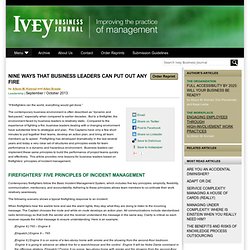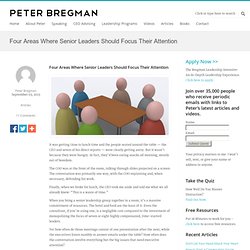

11 Positive & Proactive Performance Management Strategies. 11 things that CEOs can learn from Marissa Mayer's struggle. Why IBM Is In Decline.
Military practices in business. Customer service. Public Sector. Innovation. Why Bureaucracy Must Die. Why You Shouldn't Reward This Kind of Problem-Solving Employee. “Lose a million dollars in your first month.”

That's the advice I shared with a friend who joined a new company to oversee risk management. Lessons in Leadership from the Fukushima Nuclear Disaster. Three widely cited investigations of the Fukushima disaster — one by the Japanese government, one by an independent team of experts in Japan and a third by The Carnegie Endowment for International Peace — have now concluded that the nuclear disaster of March 2011 was not, as it first seemed, the inevitable result of events no one could have predicted.

“It was a profoundly man-made disaster that could and should have been foreseen and prevented,” said Kiyoshi Kurokawa, chairman of the Fukushima Nuclear Accident Independent Investigation Commission, established by the National Diet of Japan. In an effort to understand what went wrong and what lessons in leadership the tragedy can offer, leaders directly and indirectly involved in the disaster spoke candidly at the Tokyo panel on Fukushima sponsored by Wharton’s Initiative for Global Environmental Leadership (IGEL). Strategic Planning: A Roadmap to Success. Strategic Planning is among the most widely used and perhaps among the most abused management terminology in modern day business.

If one were to ask the CEO of any large organization why Strategic Planning is needed, the responses would be varied: Resources are finite and we need to have clear line-of-sight towards how and why we allocate our resources and to what end…We need a structured process for highlighting opportunities / risks in order to sustain and accelerate the growth momentum..We need to have a defined game-plan for taking on the competition…And the list would go on.
Strategic Planning The question that one needs to ask is “What exactly is meant by strategic”? There are hundreds of books written on this subject and its use in business is nothing new, therefore Strategic Planning should be relatively simple, right? FOLLOWERSHIP: THE OTHER SIDE OF LEADERSHIP. The link between leadership, management and enterprise performance is widely understood and accepted.

Improving leadership improves management and raises the probabilities of better performance. That boards often change leaders when enterprises are slipping confirms the importance placed on leadership. The flip side of leadership is followership. It stands to reason that if leadership is important to performance, followership must have something to do with it too. Nine ways that business leaders can put out any fire. “If firefighters ran the world, everything would get done.”

The contemporary business environment is often described as “dynamic and fast-paced,” especially when compared to earlier decades. But to a firefighter, the environment faced by business leaders is relatively static. Compared to the experience of fighting a fire, business leaders dealing with a changing environment have substantial time to strategize and plan. Fire Captains have only a few short minutes to pull together their teams, develop an action plan, and bring all team members up to speed. Firefighting has developed dramatically in the last several years and today a very clear set of structures and principles exists for team performance in a dynamic and hazardous environment.
Firefighters’ Five Principles of Incident Management Contemporary firefighters follow the Basic Incident Management System, which includes five key principles: simplicity, flexibility, communication, meritocracy, and accountability. Equipment Training.
Four Areas Where Senior Leaders Should Focus Their Attention « Peter Bregman. It was getting close to lunch time and the people seated around the table — the CEO and seven of his direct reports — were clearly getting antsy.

But it wasn’t because they were hungry. In fact, they’d been eating snacks all morning, mostly out of boredom. The COO was at the front of the room, talking through slides projected on a screen. The conversation was primarily one way, with the COO explaining and, when necessary, defending his work. Finally, when we broke for lunch, the CEO took me aside and told me what we all already knew: “This is a waste of time.” When you bring a senior leadership group together in a room, it’s a massive commitment of resources.
'Continuous Productivity' and the Next Generation of Work and Tools For Work. Transform your business with a simple change. When business owners try to strengthen their companies, they usually focus on big fixes: acquisitions, expansions, world-class products and bold new markets.

Yet some of the best fixes are on the softer side: reinventing the way you manage your company. Imagine if your business truly became world-class at customer service, or training sales staff. Or if you actually learned to delegate. Anyone can copy your products or your latest marketing campaign. But the softer skills are tougher to master, which makes them compelling competitive advantages. Case in point: At a conference a few weeks ago, I was surprised to hear a speaker urge entrepreneurs to build their businesses by creating more effective meetings. Have an objective for every meeting — a really clear outcome. Paula Harrington is senior manager with Deloitte Consulting in Toronto, specializing in talent development.